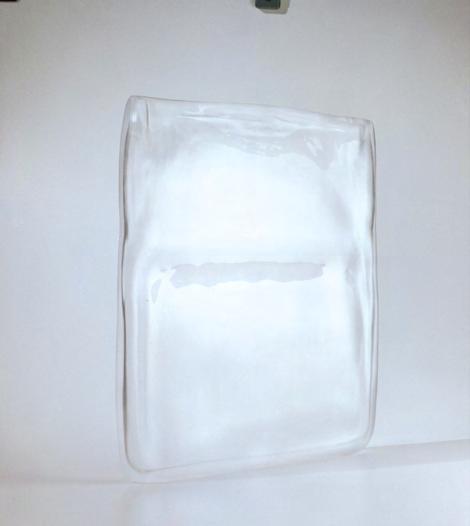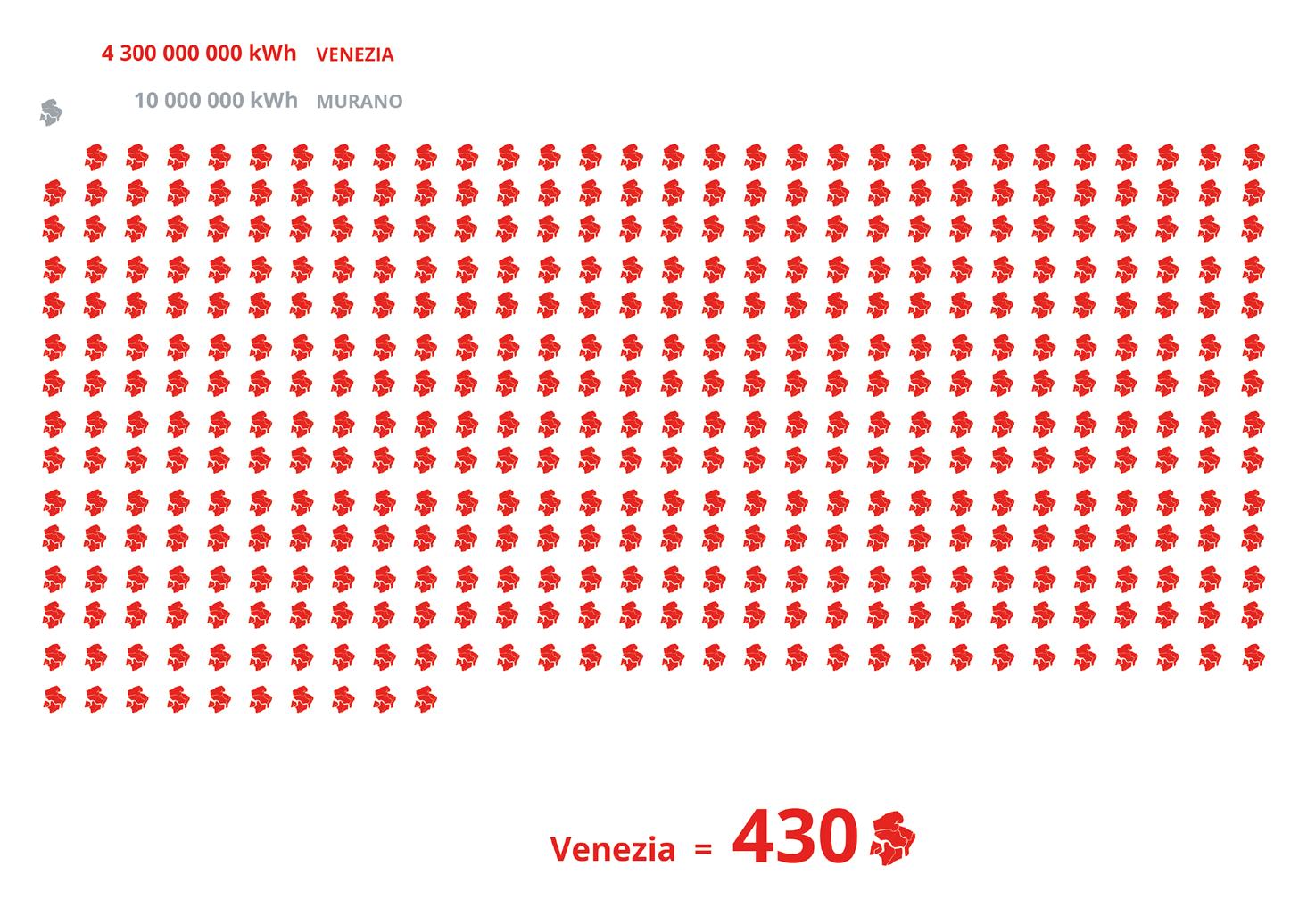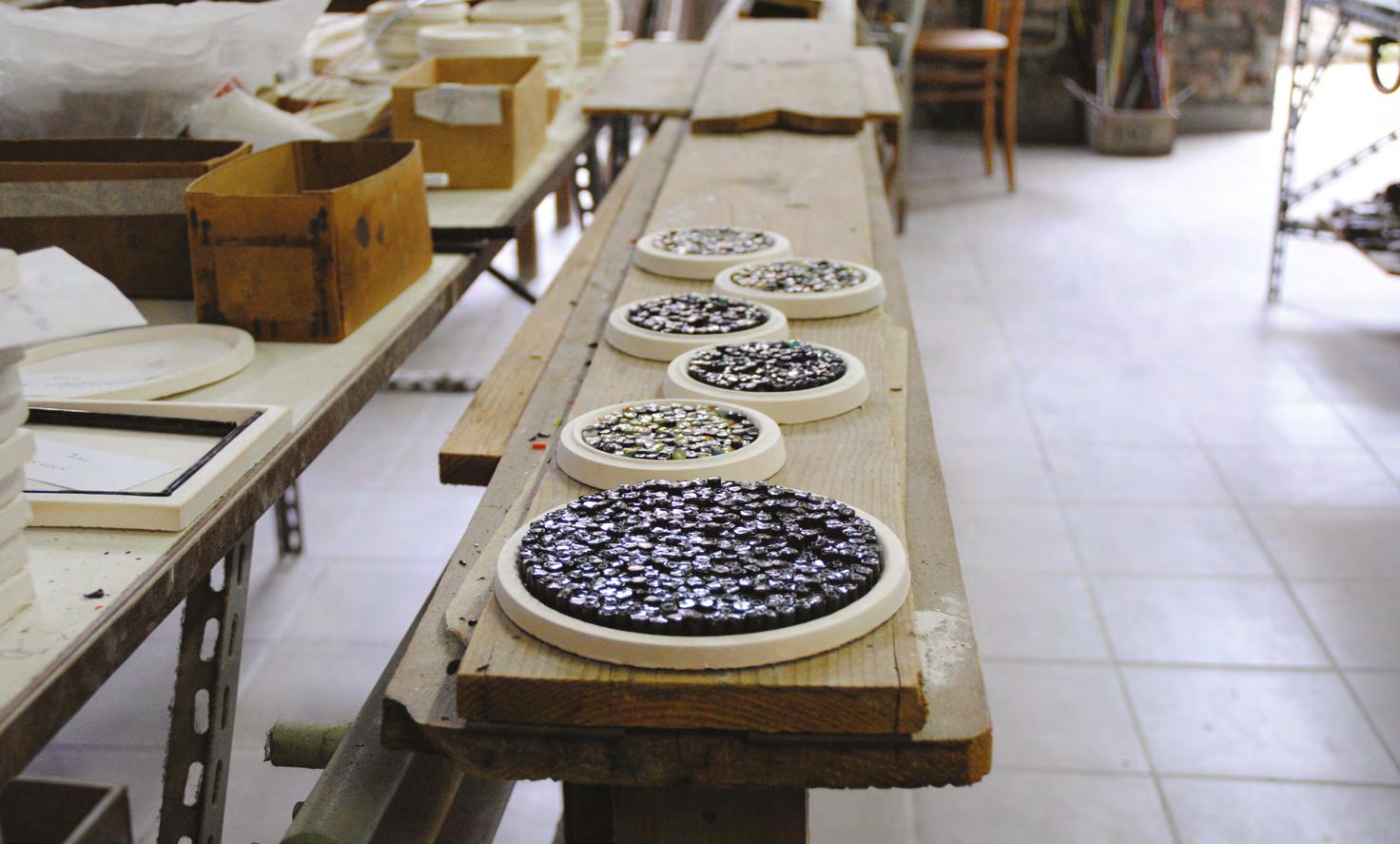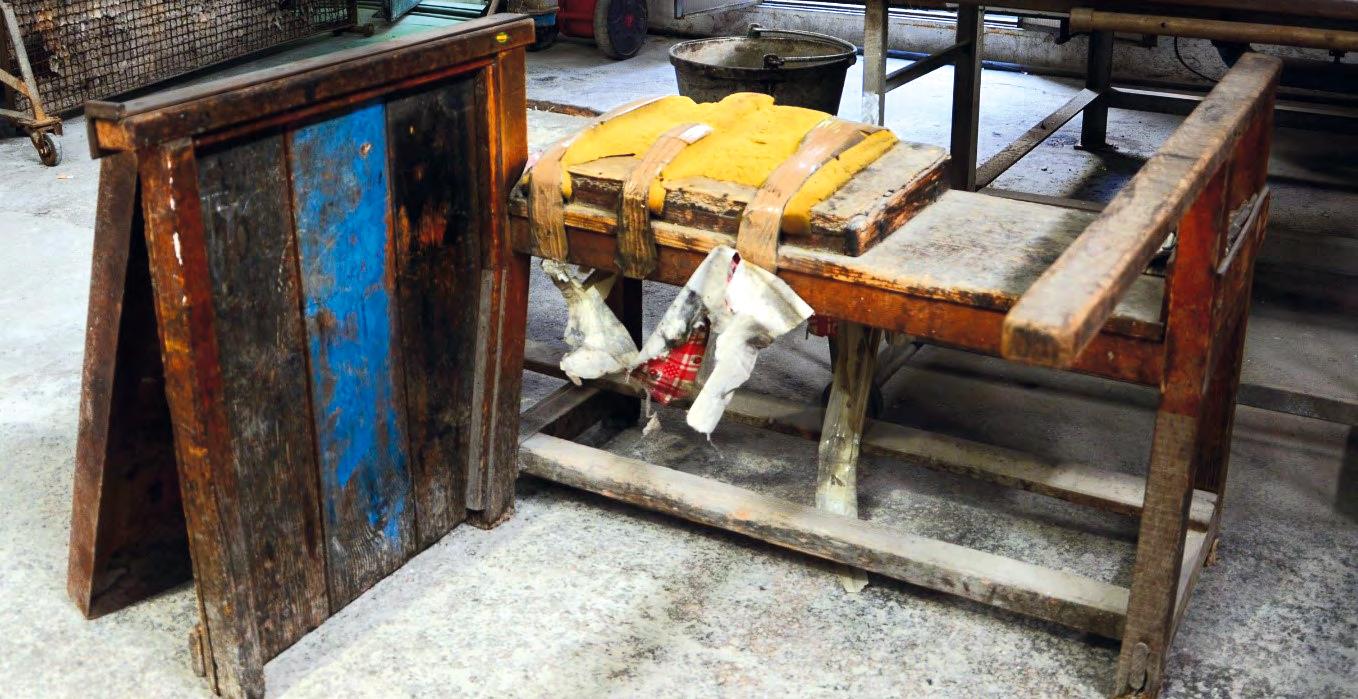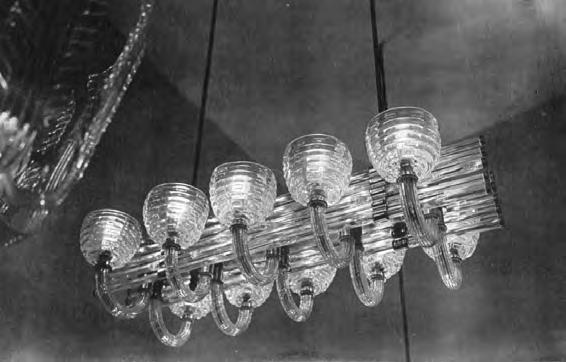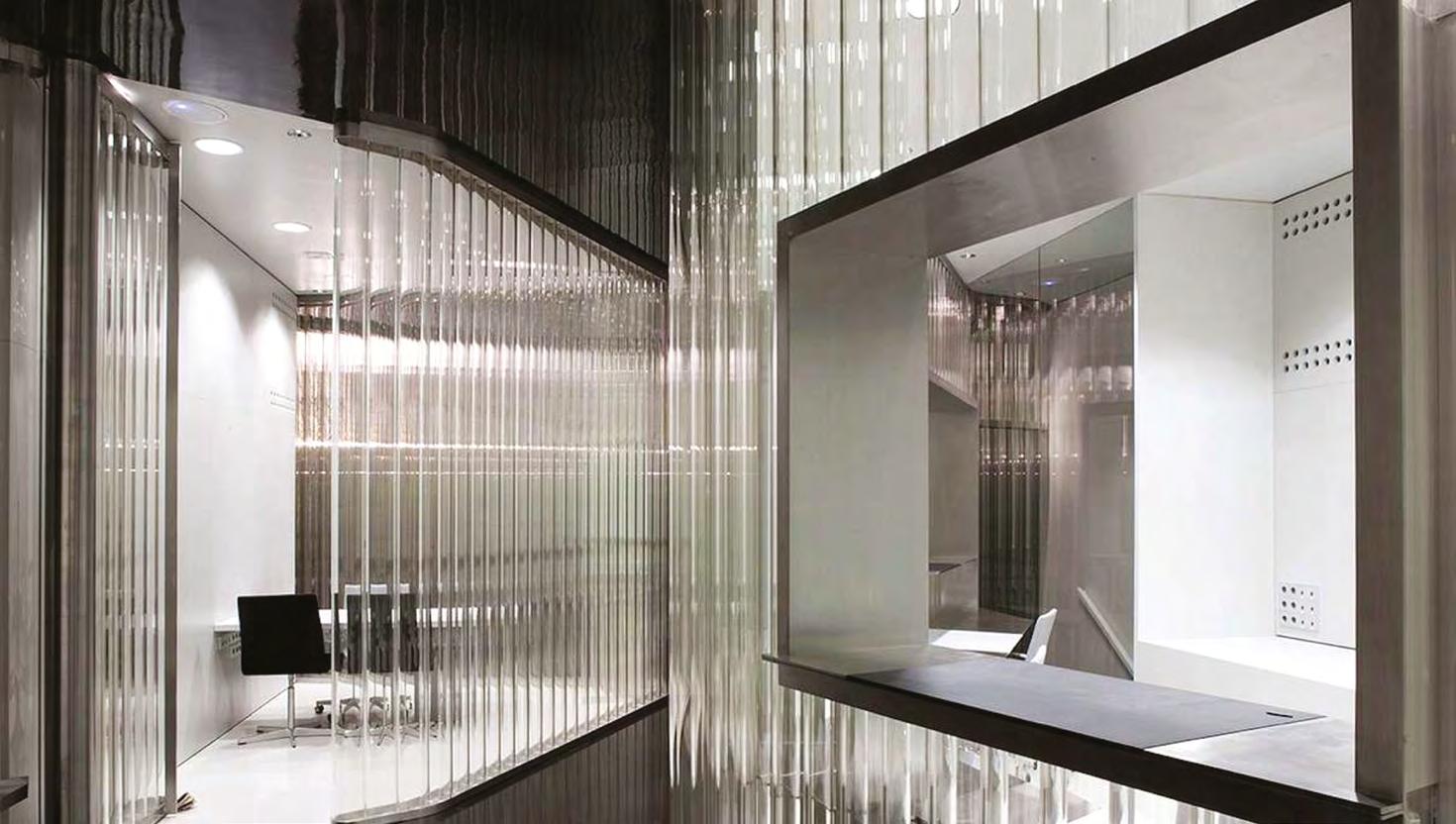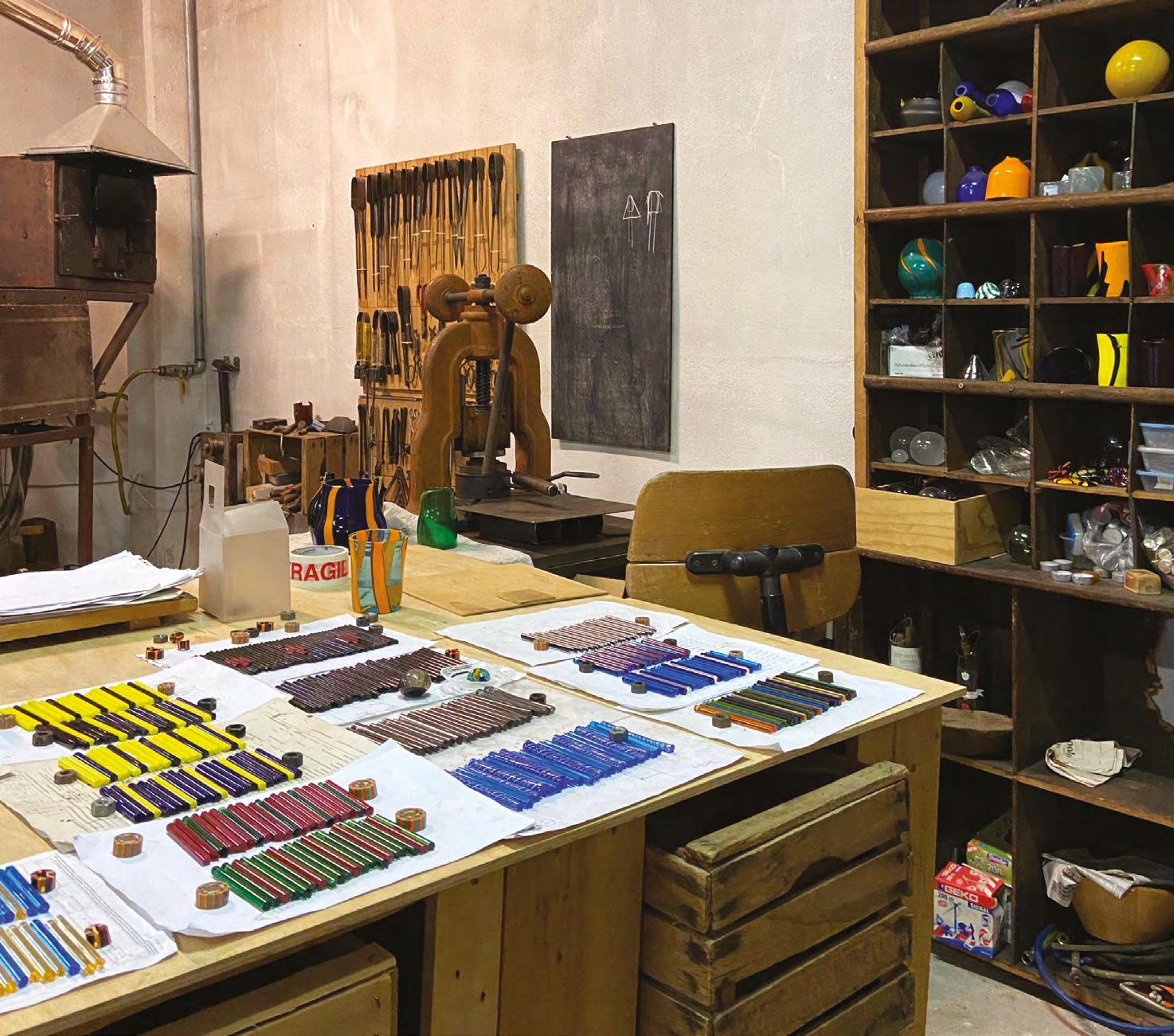
18 minute read
Authorship in Glass Design in Portugal- Four Cycles: from 50´s to Contemporaneity
CLÁUDIA PEDRO SANTOSA
This study consolidates scattered information, complementing the knowledge of the history of glass design in Portugal, from 1950 to now, focusing on authorship in glass design, integrating the profiles of professionals who developed product for Portuguese companies.Most of them closed at the beginning of this century. In the Marinha Grande Cluster, where many of these manufactures were installed, the consequences have been devastating from a social and economic point of view. Our study is a contribution to make the historiography of an intellectual and technical production of a knowledge with more than two and a half centuries in this territory, by transforming matter into products with an identity, that means an antifragile cultural heritage, between history, art and design.
A Department of Arts, Faculty of Arts and Letters, University of Beira Interior, Portugal
KEYWORDS: GLASS, DESIGN, PORTUGAL
Introduction
Glass has been subject of numerous scientific studies: archaeological, industrial (history andproduction), architectural and construction, from the point of view of engineering materials (perspectives of chemistry and physics), techniques and technologies, production, arts and also product design. About the history of design in Portugal, there is a lack of instalment studies, so our research aims to be a significant contribution to the development of historiographic projects on glass. Thus, we have arisen the opportunity to deepen our knowledge of glass in the Portuguese context, within the framework of this project. This research, Authorship in glass design in Portugal, as the title indicates, focused essentially on the study and contextualization of the life and work of the designers who acted in the scenario of the glass industry in Portugal since the second half of the twentieth century, until now. It was our objective to study, treat and map the authorship in glass design in Portugal, in the second half of the twentieth Century, in order to be known designers, their performance in the glass industry in Portugal and the products they developed.
Four cycles of portuguese glass design
The national glass industryrevealed an intense activity throughout the second half of the twentieth Century, a situation that had repercussions on product design and to some extent was a consequence of the scientific appropriation of this project area in the Portuguese business. Until the mid1970s, glass design was a territory explored by several creative professionals: artisans, artists, plastic artists, designers, architects and, later, by designers, after the first higher courses in design emerged, namely at the Institute of Visual Arts and Design – IADE, ESBAL – Escola Superior de Belas-Artes in Lisbon, ESBAP – Escola Superior de Belas-Artes do Porto and the National Society of Fine Arts – SNBA (Santos, 2015). Glass, due to its physical-chemical properties, as a material, the multiplicity of aesthetic aspects it can offer and the variety of processes, technologies and techniques that can be experienced in it, has always been a matter that all artists and creatives of material culture and in the area of product development wanted to explore. By necessity or by desire, this “matter of invention” (Manzini,1986), of a unique plasticity, offers applications in distinct areas as architecture, engineering, civil and shipbuilding, the automotive industry, optics, some packaging typologies such as bottles and flasks, laboratories, telecommunications, pharmaceutical, applied arts, sculpture and design. In design practice, glass can be explored under an industrial, semi-industrial, handmade or artistic aspect. In the industrial and semi-industrial context, however, there has always been a need, not only to meet project requirements, articulating form
and function, but by social and identity circumstances, among others, there has been a need for, for example, a glass of water to be more than a mere functional container, which leads us to mouth-watering and thus to reach territories of the fine arts, utilitarian arts, decorative arts and crafts with enlarged meanings. In the history of design in Portugal and specifically in the present study, we found that in the chronology covered by this research, in the 1950s and 1960s, there were already forays into the design of glass products, with an authorial aspect.
1st Cycle
From this 1st Cycle of designers, we identify 34 important figures of the national scene, such as Thomaz de Mello (Tom), who triedan introduction of a new aesthetics in the glass industry in Portugal or Bernardo Marques andJorge Barradas who represented drawings or prints with folk themes produced by the factory Companhia Industrial Portuguesa – CIP.Authors like Abel Agostinho, Alice Jorge, Júlio Pomar, Carmo Valente, Maria Helena Matos, Eduardo Afonso Dias, Eduardo Marinho, GéraldGulotta, José Aurélio, Armando Melo among many others who we found, produced the main work of this 1st Cycle of glass designers in Portugal with the meaning of unite industry and arts. However, and after the international oil crisis (1973), which the country also felt, and the social disturbance immediately after 25thaprilof 1974, the Portuguese glass industry, which had ended in its 1st Cycle – with special visibility in the and 2nd Exhibitions of Portuguese Design (1971-73)and in the International Exhibition of Manual Glasswork (1972) – entered into stagnation, which lasted until the mid-1980s (Constantino, 1969).
2nd Cycle
During this period, there was almost no orders for a glass product project by the factories. Fábrica-Escola Irmãos Stephens – FEIS, still intent on bringing art and industry closer together and fostering the artistic aspect in glass production, invited in this decade several glass specialists to disseminate technical knowledge in glasswork, having attributed itself to the 2nd Glass Design Cycle in Portugal the editions of the Young Designer Competition in 1985, by Centro Português do Design – CPD where glass was a material experienced by designers in the Portuguese industry. In 1988, the renowned American glass artist Dale-Chiuly came to Portugal to organize his exhibition at the CalousteGulbenkian Foundation – FCG and hold a workshop at FEIS. The aim was not to develop a product for industry, nor large series, i.e.with the exclusive intervention of the machine and with an underlying aesthetic component, but rather to give rise to creative discourses, in which the authors re-wrote themselves in their projects, arousing the complicity of urban audiences, speaking of themselves and transposing themselves to the matter, for the forms, responding to functions, using the techniques

01 02 03

04 05 06


08 09 07
10
Fig 01 Jars and solitaire. Design by Carmo Valente. Cristal. FábricaEscolaIrmãos Stephens - FEIS, 1960. Fig 02 Solitaire, bowl and jars. Glass. Design by Maria Helena Matos. Blowed glass, moulded, chiseled whith metal wheel and polish at acid, 1960. Fig 03 Pieces of de table set II CENTENÁRIO. Design by Maria Helena Matos. Cristal. Fábrica Escola Irmãos Stephens – FEIS. Blowed-molded and lapidated cristal, 1969. Fig 04 Set of glasses AQUA. Design by Eduardo Afonso Dias. Glass. Crisal Glass. Automatic blowed glass, 1973. Fig 05 Jugs and glasses ORION. Design by José Eduardo Marinho. Glass. Fábrica Escola Irmãos Stephens, 1971. Fig 06 SATURNO Lamp. Design by Margarida de Ávila. Glass. Ivima, 1971. Fig 07 Jar. Design by Alice Jorge. Glass. FábricaEscolaIrmãos Stephens, 1956. Fig 08 Set of glasses CHROMATICS. Design by Gerald Gulotta. Glass. Crisal, 1971. Fig 09 Ashtrays/bowls A-12-G. Design by Ascenso Belmonte. Glass. Ivima, 1960. Fig 10 Two polyvalent pieces: bowl and dish. Prize Fundo de FomentoExportação at International Competition of Manual Glasswork. Design by Vitor Manaças. Glass. Fábrica Escola Irmãos Stephens, 1972.
and processes with which they most identified. In a word, freed from the constraints imposed by industry and the tyranny of markets. These pieces, in limited editions, had higher costs and rivalled works of art. Influences of European and contemporary glass production, namely Murano (Italy), Loraine (France), Bohemia, Scandinavia and Eastern countries began to be known in Portugal, sum in an aura of prestige that lacked the national production: the old custom of valuing “foreign junk” – as well saw the author of Repensar Portugal (Antunes, 2006), combined with the belief in the advantages of counterfeiting, facilitated by the visits of entrepreneurs to the reference fairs of glassware and tableware in Europe, enhanced by an unfavourable national conjuncture, make up the sad reality of the national glassware industry. It was then that, along with the international outbreak of author design, Portuguese designers began in the edition of limited series, in parallel with what was already being done in Europe and in the world: with the creation of Studio Alchimia in 1976 or the Memphis Group in 1981, founded by Ettore Sottsass in Milan. Names like Niza Falcão, João Camacho, Eliane Marques or Isabel Dâmaso are part of this cycle. The Memphis group criticized the evolution of the shape of objects only in relation to their function, not subscribing to the indifference by their aesthetic function and symbolic function. Sottsass believed in the search for the identity of objects, from the most provocative, through playful, eccentric and even merely decorative. The aim was to instigate the meaning of products and open new paths to design. In Portugal, in the late 1980s, the Ex-Machina Group formed by young designers Paulo Parra, José Viana and Raúl Cunca emerged in the late 1980s, and in the 1990s, there was a 3rd Cycle of Glass Design, when the IN-FUSÃO factory launched project briefings to designers, having had the participation of Paulo Parra, with his Aqua Chair (CPD-Centro Portuguese do Design, 2000) and Raúl Cunca (Cunha, 2019), with The Scirocco Container, already in an author’s project context. Given the difficulties of dialogue between designers and industry – it is not important to take blame now – and the recent training offer of designers, these young professionals began to partner in glass studios, developing and producing their pieces, also responding to the reduced permeability of the national industry for experimentation. However, most of these pieces, even those that could have longer series, failed to capitalize on their transformative potential, so little designers were with proper distribution and marketing techniques to put their products on the market. Thus, many pieces were only in prototype or were edited in small series.
3rd Cycle
It was notorious, on the part of the glass industry, the attempt to revitalize the sector, which was located mainly in the area of Marinha Grande – where VITROCRISTAL ACE was created in 1994 – and in Oliveira de Azeméis, where
the Centro Vidreiro do Norte de Portugal was installed. Through the use of several strategies, one of them was design – either by the initiative of designers in solo or multi-author projects – as did Marco Sousa Santos (Santos, 2012), through Protodesign, with the project SWR – Sweet Revolution in 1999 (using the blown mould rotated as a semi-industrial basic process of product development), or the Project Sangue Branco (whose main concept was from pre-existing laboratory glassware, and exploring their systematic nature, developing lighting objects) – or, either on the initiative of some companies – such as Atlantis factory, through PROJECT 01 in 1999/2000 (Best of 180 Design Products Portuguese, 2003) and Think-Thank (Santos, 2001). This company has submitted invitations to renowned Portuguese and foreign designers to develop glass product collections for everyday use, with unusual approaches to material and design.
In the late 1990s, the demarcated region of Marinha Grande glass was implemented, as if a cluster were treated. RVMG – Região do Vidro da Marinha Grande, with the MGlassbrand, has associated national companies in the sector, following a market strategy towards the active integration of young designers in product development, with the purpose of competing with the main European glass cores, affirming the national glass production. However, few glass processing companies turned the Century without serious financial problems. We note that we have seen the fact that some designers have acted in more than one cycle, since their activity is transversal over time. We highlight the name of the architect Álvaro Siza Vieira who is contemporary in the age to the designers of the 1st Cycle, began the editing of glass objects in 1975, having been inserted in the 2nd Cycle of Glass Design in Portugal, continued to edit glass pieces in the chronology of the 3rd Cycle and these days are still edited in glass series of his own.
4th Cycle
We found an opportunity for research in the study of glass design authors in Portugal in the first two decades of the 21st Century (2000-2020), as they emerge like an extension of the time period covered by our current research and that we are aware that there are works of designers/authors to historiograph, according to a summary mapping that we carried out, as well as the existence of scattered bibliography to be consulted. There is a new wave of designers/authors of glass design in Portugal, whose performance has taken place in the last two decades. One of the projects is Glass Care (Almeida, 2020) carried out by the Gallery Off Portugal, and in agreement with VÍCARA, an author design editor and publisher, based in Caldas da Rainha and CENCAL1, in Marinha Grande, having as one of the mentors, Paulo Sellmayer product designer, including glass products. In this event,
1 CENCAL –Centro de Formação Profissional para a Indústria da Cerâmica.
11 12 13 14
15 16 17 18



19
22 20

23 21
24 25
Fig. 11 ÁGUA Chair. Design by Paulo Parra. Glass. Molded by slumping technique. In-fusão, 1998. Fig. 12 SIROCO Container. Design by Raúl Cunca.Glass. Molded by floating/slumping technique. In-fusão, 1998. Fig. 13 Glasses bowls/flutes. Design by Eliane Marques. Cristal. ATLANTIS – Cristais de Alcobaça, 1998. Fig. 14 Container and centerpiece PROJECT 01. Design by Hugo Amado. Cristal. Vista Alegre Atlantis, 2000. Fig. 15 Set of bowls- PROJECT 01. Design by Filipe Alarcão. Cristal. Vista Alegre Atlantis – VAA, 2001. Fig. 16 Jar and glasses. STANDARDS MGlass. Design by Fernando Brízio. Glass. Canividro, 2001. Fig. 17 Jarras 2,3,4. Design by Architect Álvaro Siza Vieira. Glass. MSI, 1996. Fig. 18 Ashtrays HAVANA. Design by Architect Siza Vieira. Glass, MSI. Fig. 19 Set of vases and bowls BUBBLES COLLECTION. Design by Paula Lomelino. Glass. Vetricormglass, 2000. Fig. 20 Set of bottle and glasses FUNNY TOUCH. Design by Ana Flôrand Carla Mendes. Glass. Marividrosmglass, 2000. Fig. 21 Bowls/containers REVERSE COLLECTION mglass. Design by Cláudia Pacheco. Glass. IVIMAmglass, 2002. Fig. 22 Vases MANHATTAN TOWERS. Design by Margarida Garcia. Glass blowed into metal. Marividrosmglass, 2000. Fig. 23 Jars, vases, bowls and Solitaires REVERSE. Design by Cláudia Pacheco, Margarida Garcia e Paula Marques. Vidro. IVIMAmglass, 2000. Fig. 24 HYBRIS Jar/vase. Design by Alda Tomás. Ecologic glass. Jasmim/Vicrimagmglass, 2000. Fig. 25 Lampstand GLASS AN IRON BLOCK. Design by David Matos. Glass. Tosel/Tovilmglass, 2000.
we could know the projects of Samuel Reis, an emerging Portuguese young designer who is inspired by nature as we can see in the CERNE collection (Silva, 2015), whose connection with the conceptions of Scandinavian glass (Design: The Definitive Visual History, 2015), we cannot fail to do and we also considered as an incentive for study and research, the work of designer Vitor Agostinho, which we have classified as integrated into the 3th Cycle of Glass Designers in our work, although he continues to design and develop glass products, as it´s the case with his project Mutants Moulds and the Polyhedron collection. In this sense, we recommend the development of dissemination and awareness-raising actions, identical to the afore mentioned ones, on the social and economic importance of preserving and promoting the development of the glass industry in Portugal. In this new century, we found multi-author glass design projects that emerged in Portugal, as was the case of White Blood created by designer Marco Sousa Santos (Santos, 2012), or Standards projects (Bártolo, 2014) Workshop 25 cl or Women in Glass for Mglass.
Conclusion
With this work, we sought to contribute to the consolidation of the histography of design in Portugal mapping design authorships and Portuguese glass. We believe that in order to act in the present and prepare for the near future, it is necessary to know the past. In this sense, through a scientific method based on direct observation, questionnaires and interviews carried out, we mapped a set of authors and their projects, in order to categorize and group them into four chronological cycles characterized by techniques,period of glass product development. Factors such as competition from glass from eastern European countries (at lower costs), the implementation of large areas (which sell European glass and offer quality products at reduced costs), the lack of formal, conceptual and aesthetic identity ofPortuguese glass, the high energy costs in Portugal (gas and electricity), the absence of recognition of design as a projective discipline by most. Portuguese entrepreneurs, the meager recognition of the work of glass masters and workers, the unsatisfactory working conditions, with harmful effects on health and their low salary remuneration, the resistance to the industrialization of a sector with a very strong artisanal tradition, the lack of project culture, the scarcity of good communication between entrepreneurs, designers and glassware, the difficulty in predicting trends and developing products beyond the most routine horizon are some of the multiple factors portrayed throughout this work and which undertake the current destruction of a significant part of the industrial fabric of glass in our territory in the first two decades of the 21st Century. There will be a place for the author’s design, and this is certainly one of the key paths to follow, so that we can see a
possible plan of revitalization of the Portuguese glass industry assured. At the conclusion of our study, we found that only the companies that were able to adapt, applying design strategies or those that bet on investing in the development of high consumption products, were able to survive – such as the processors/producers of packaging glass (automatic domestic glass, bottlery), glass for scientific, optical, civil construction, components for the automotive industry and for electricity producers. With regard to the general objectives that we set at the beginning of our work and which consisted of knowing and making known in glass design in Portugal, from 1950 to now, we consider that we met the objectives envisaged, although we were already aware of some authors of the 1st , 2nd and 3rd Cycles of Glass Design in national territory, we have come now and at the end of our research, amplify and consolidate our knowledge on the subject and map it, so that we can easily make it known to those who are interested in deepening these contents. As for the specific objectives of this research, these were initially based on the mapping of design and glass authorship in Portugal, as well as on compulsion of scattered information, preserving and rescuing from oblivion a unique material and cultural heritage, conceived by the particular and multifaceted authorship in Glass Design since the second half of the twentieth century in Portugal, until now. Thus, we understand that this planning was carried out by us designed, and we produce theoretical information complemented by graphic and visual information that helps to know the authorships in glass design in Portugal that allows more immediate interpretation of the context of the historiography of glass design, in the 2nd half of the twentieth century until now in Portugal, as well as the current and subsequent theoretical production, thus preserving the material and cultural heritage of Portuguese glass design. We consider that the mapping and study of authorship in glass design in Portugal, from 1950 to nowadays, is a fundamental contribution to knowledge and particularly to the Portuguese History of Design. We leave open the suggestion that one of the possibilities of re-industrialization of the glass sector could be the association of companies of the Table Row, to develop new products, including glass with other materials, which combines tradition with innovation and high added value, in which it could be the designers to develop an awareness campaign, to these companies, for this need that could be of common interest.
References
Almeida, T. (2020). Design Glass Objects: The Portuguese Panorama. Arts, 9, p. 79. Bártolo, J. (2014). Pequena Históriadas Exposições de Design em Portugal (ca. 1990-2010). Lisboa: Ed. Camões. Best of 180 Produtos de Design Português (2003). CPD-Cent. Lisboa, Portugal: CPD - Centro Português do Design. Carvalho, P. (2019). Pop & Tutti Frutti: O Vidro Em Portugal Nos Anos 60 et 70: Colecção Pedro Moura Carvalho: Portuguese Glass in the 60s et 70s: Pedro Moura Carvalho Collection. Marinha Grande Portugal: Museu do Vidro. Constantino, J. (1969). Algumas Considerações Sobre a 1a Exposição de Design Português. Lisboa: Binário. Costa, D., Martins, J.P.(2003). Manual de Referênciapara o Design no Sector da Cristalariada Marinha Grande. Edited by Atelier Daciano da Costa Arquitectura e Design. Coutinho, B., Souto, M.H. (2017). Ensaio Para UmArquivo: O Tempo e a Palavra: Design Em Portugal (1960-1974) = Rehearsal for an Archive: Time and Word: Design in Portugal (1960-1974). Lisboa: CML MUDE - Museo do Design e da Moda Colecção Francisco Capelo. CPD-Centro Português do Design, (ed.) (2000). O Tempo Do Design: Anuário 2000 - Ano Oito - N. º21/22. Lisboa Portugal: CPD-Centro Português do Design. Cunha, R. (2019). Raul Cunca: Design Para a Vida= Design for Life. Castelo Branco: CâmaraMunicipal de Castelo Branco. Dias, E., Pinto, C. (2014). O design possível: 50 anos de profissão / Eduardo Afonso Dias. Lisboa: MUDE - Museu do Design e da Moda. Exposiçāo Vidro Manual (1972). Hand-Made Glass Exhibition = HandglassAusstellung = Exposition Verre-Main. Lisboa: Grémio Nacional da Indústra Vidreira. Frederico, D. (2007). Os Trabalhos de Alda Tomás. Suplemento Ípsilondo Jornal PÚBLICO de 03.08.2007. Instituto Nacional de Investigação Industrial (1973). Catálogo da 2a Exposição de Design Português. Lisboa: Imprimarte S.A.R.L. Instituto Nacional de Investigação Industrial (1971). Catálogo da 1a Exposição de Design Português. Lisboa: Imprimarte S.A.R.L. Matos, M. (1959). Exposição de Vidros M. Helena Matos. Lisboa: S.N.I. Santos, R. (2015). Design português. Vila do Conde: Verso da História. Santos, R. (2014). Históriado Design em Portugal entre 1974-2010. CAMÕES: Revista de Letras e CulturasLusófonas, n. 23, pp. 37-50. Santos, R. (2004). Vidro e Cristal Portugueses Contemporâneos. Lisboa: Arte Teoria. Santos, R. (2001). Vidros e Design: Carmo Valente. Arte Ibérica. Lisboa: Editora Arrábida. Santos, R. (1995). Design e Decoração: 1900-1994. Históriada Arte Portuguesa (Dir. Paulo Pereira), Círculo deLeitores, pp. 492-498. Silva, S. (1983). Design & Circunstância: Conformismo & Subversão. Arquitectura. Lisboa.

